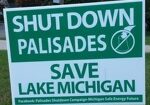Palisades: ASLB rejects new/amended environmental contentions

[Yard sign design by Michigan Safe Energy Future-Kalamazoo Chapter and Shut Down Palisades Campaign; photo by Kevin Kamps.]
On June 20, 2025, the three administrative law judge panel at the U.S. Nuclear Regulatory Commission Atomic Safety (sic) and Licensing Board overseeing the Palisades closed reactor restart proceedings ruled against our environmental coalition’s new and amended environmental contentions.
Our legal counsel, Terry Lodge of Toledo, Ohio and Wally Taylor of Cedar Rapids, Iowa, filed the new and amended contentions in response to NRC staff’s recent publication of its Environmental Assessment/Finding of No Significant Impact.
Thus far, since early December 2023, the ASLB, NRC staff, and NRC commissioners have ruled against, or rejected out of hand, every single one of a large number of contentions, intervention petitions, and requests for hearings, that our coalition has submitted, in opposition to Palisades’ restart. However, we must exhaust all administrative remedies at NRC, before we can appeal to the U.S. federal courts.
The intervening environmental coalition includes Beyond Nuclear, Don’t Waste Michigan, Michigan Safe Energy Future, Nuclear Energy Information Service of Chicago, and Three Mile Island Alert of Pennsylvania.
The notion that restarting the 60-year old (it was designed in the mid-1960s, ground was broken in 1967, it fired up in 1971, then operated till 2022), lemon from the get-go, perpetually problem-plagued Palisades atomic reactor will involve no significant environmental impacts is, of course, absurd.
Dangerously so.
The “zombie” reactor restart risks a Chornobyl- or Fukushima-scale environmental catastrophe, actually.
Our expert witness, nuclear engineer Arnie Gundersen, wrote an essay about the catastrophic risks to the Great Lakes at Palisades, a decade ago. The age-related degradation risks have only grown much more severe since then.
A 1982 NRC report — CRAC-II (Calculation of Reactor Accident Consequences) — calculated that a reactor core meltdown at Palisades would cause a thousand acute radiation poisoning deaths, 7,000 radiation injuries, and 10,000 latent cancer fatalities. CRAC-II also calculated that a Palisades meltdown would cause $52.6 billion in property damage.
Adjusting for inflation alone, to today’s dollar figures, property damage would surmount $168 billion.
And as reported by Jeff Donn at AP in 2012, the population around Palisades has increased significantly since 1982, so casualties would increase corresponding, as more people now live in harm’s way. Donn also reported that neutron embrittlement of reactor pressure vessels is a top example of NRC regulatory retreat. Palisades has the worst embrittled reactor pressure vessel in the U.S., NRC has been forced to admit. It is tied for worst with Point Beach Unit 2 in Wisconsin, meaning Lake Michigan is wedged between. Gundersen has stated that Palisades is the most embrittled RPV in the world.
Support Beyond Nuclear
Help to ensure a safer, greener and more just world for all

